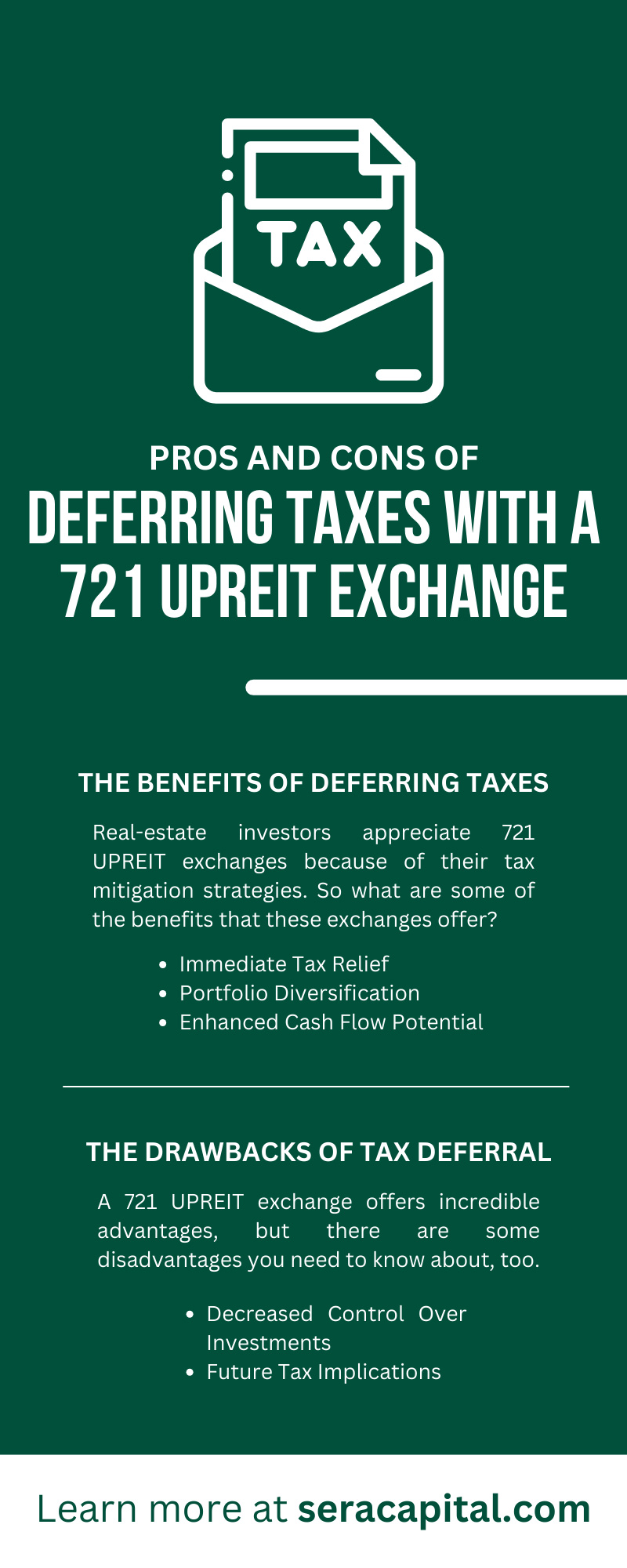Pros and Cons of Deferring Taxes With a 721 UPREIT Exchange

Carl E. Sera, CMT
March 1, 2024
Navigating the world of real-estate investment is akin to a strategic chess game, where every move has the potential to significantly affect your financial future. This analogy is particularly accurate when you’re considering the intricate interplay between asset management and tax implications. One strategic move that has garnered attention, particularly among real-estate investors, is using 721 UPREIT exchanges to defer significant taxes.
This detailed exploration dives into this method’s mechanics, advantages, and accompanying pitfalls. Continue reading to explore the pros and cons of deferring taxes with a 721 UPREIT exchange.
The 721 UPREIT Exchange, Unboxed
The 721 UPREIT (umbrella partnership real-estate investment trust) exchange is a tax-deferred strategy that allows real-estate investors to exchange their direct ownership in real estate for shares in a partnership. This partnership is generally a publicly traded REIT that functions as a tax-deferred exchange under Section 721 of the Internal Revenue Code. An REIT creates a temporary Delaware statutory trust (DST), allowing 1031 exchangers to invest or purchase in the DST under section 1031. Once the process is complete, the 1031 exchanger owns the REIT.
Grasping the foundational concept behind the 721 UPREIT exchange is vital. This transaction involves contributing property to an operating partnership in exchange for units or shares. You can transfer property values from a lump sum to smaller regular payouts. This mechanism is known for its tax-deferment advantage and its ability to enhance portfolio diversification.
The proposition of deferring capital gains tax recognition on their initial real-estate investments can entice investors. But the question remains: Does the reward outweigh the risk?
The Benefits of Deferring Taxes
Real-estate investors appreciate 721 UPREIT exchanges because of their tax mitigation strategies. So what are some of the benefits that these exchanges offer?
Immediate Tax Relief
One of the most tangible benefits of employing a 721 UPREIT exchange is the immediate relief from hefty capital gains taxes that the investor would typically incur upon the sale of a property. By converting the asset into partnership units rather than cash, investors can sidestep these taxes, effectively deferring them to a later date.
Portfolio Diversification
By converting direct real-estate holdings into a more liquid form of ownership within a REIT, investors can expand and diversify their portfolios’ scope without the burden of immediate capital gains taxation. This maneuver permits participation in real-estate markets that may have been previously inaccessible.
Enhanced Cash Flow Potential
Switching to REIT ownership can often lead to an improved cash flow, thanks to the steady distributions these trusts produce. This stable income stream can be attractive, especially for investors with a lower risk tolerance or a need for regular cash disbursements.
The Drawbacks of Tax Deferral
A 721 UPREIT exchange offers incredible advantages, but there are some disadvantages you need to know about, too.
Decreased Control Over Investments
Transitioning to a UPREIT structure means relinquishing direct control and ownership over specific real-estate assets. Decision-making authority now rests in the hands of the partnership, potentially leaving the investor at the mercy of unfamiliar management practices or strategic realignment.
Future Tax Implications
The immediate burden of capital gains tax is relieved, but it’s crucial to note that this deferral is not a permanent exclusion. The taxable gains are simply postponed until the point of sale or liquidation of the partnership shares, which could lead to an underestimation of tax liability.
Exchanging for Complexity
The 721 UPREIT exchange is not for the faint of heart, nor is it a straightforward process. Navigating the regulatory, legal, and tax landscapes associated with this transaction can be intricate, and it often necessitates the involvement of skilled tax professionals.
Case Studies and Real-World Examples
Looking at some real-world examples can help an investor decide if this is the right opportunity for them.
A Distinguished San Francisco Developer
Consider the case of a seasoned developer in San Francisco who utilized a 721 UPREIT exchange to divest a significant portion of their real-estate holdings. By converting these into partnership units, the developer realized a substantial tax deferral and further diversified their investment strategy—all while simplifying and streamlining their portfolio management.
A Multifamily Asset Manager
For the multifamily asset manager who yearns to expand their geographical footprint or asset class exposure, the 721 UPREIT exchange offers a viable path. By taking advantage of this tactic, multifamily real estate professionals could transition from a concentrated market focus to a broader national or international portfolio.
The Suburban Investor
Conversely, a suburban investor with a prefabricated portfolio heavily weighted toward local property holdings might leverage the 721 UPREIT exchange to escape the confines of a single geography, gaining access to diverse real-estate ventures across the REIT market.
Strategic Implementation and Oversight
The decision to undertake a 721 UPREIT exchange requires meticulous planning and foresight. Essential to this strategy is the establishment of investment criteria and discerning between the various REIT options available. Additionally, ongoing monitoring and reassessment are key to aligning with evolving financial goals and market conditions.
Preparing for the Exchange
Thorough due diligence is necessary to evaluating the suitability of the UPREIT structure for your particular investment scenario. This planning involves detailed financial analysis, identification of qualifying property interests, and critical introspection regarding long-term taxation and investment tolerances. Hire a 721 exchange advisor for effortless guidance through the process.
Selecting the Right REIT
The success of a 721 UPREIT exchange hinges on the selection of a REIT that aligns with your investment objectives and offers a sound financial foundation. Criteria for REIT evaluation should encompass asset quality, geographic distribution, and historical distribution performance.
Ongoing Management
Postexchange, active management and regular review of the REIT’s performance are imperative. This ongoing management includes participating in investor calls, staying apprised of company strategy, and ensuring the partnership meets your financial expectations.
End of the Game
As with any investment strategy, the 721 UPREIT exchange warrants careful consideration of its benefits against the backdrop of its complexities. It’s a strategic tool that, when wielded wisely, can confer substantial tax advantages and supportive investment opportunities.
The Verdict
After you weigh the pros and cons of deferring taxes with a 721 UPREIT exchange, the decision is ultimately yours. A 721 UPREIT exchange is an instrument ripe with potential. However, the pathway to realizing this potential requires a deep understanding of the exchange’s intricacies and a rigorous approach to tax-planning. When you’re exploring this approach, your game plan should hinge on a well-thought-out strategy encompassing thorough financial analysis, diligent investor preparation, and vigilant postexchange oversight.
For seasoned investors and first-time players alike, the counsel of a skilled tax professional is indispensable. Their expert guidance can illuminate the tax implications specific to your situation, fortifying your position on the investment board. With due diligence and foresight, the 721 UPREIT exchange can serve as a lucrative maneuver in the real-estate investment chess game, positioning you to not only defer taxes but also chart a more robust financial future. Contact Sera Capital today for your free consultation. You’ll quickly discover why we’re the best fiduciary financial advisors out there.

Categories
Strategize Your Success
